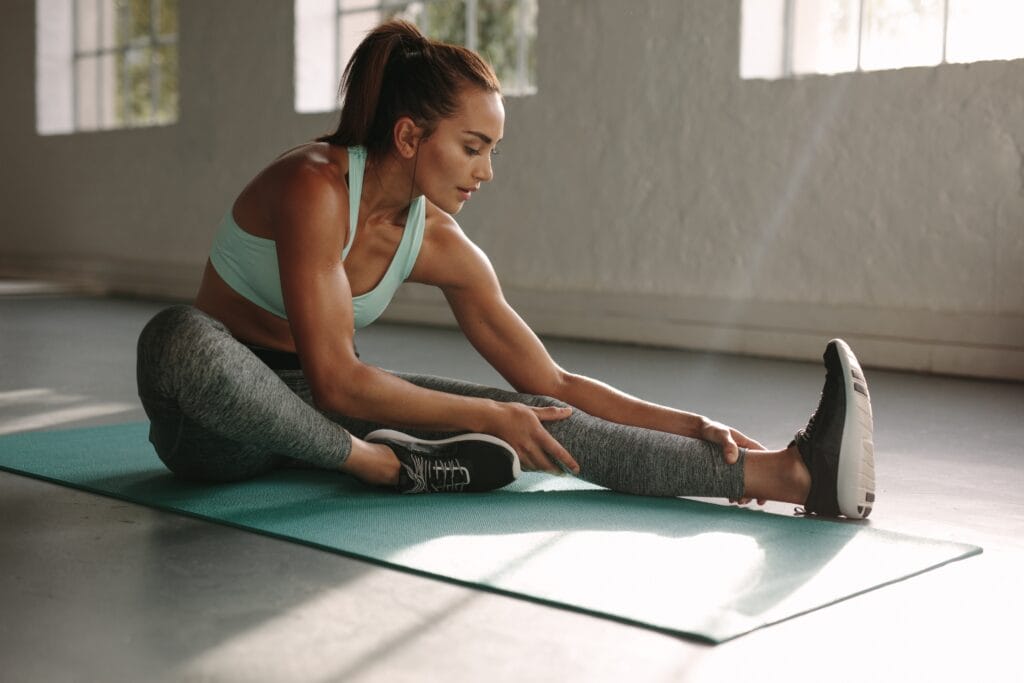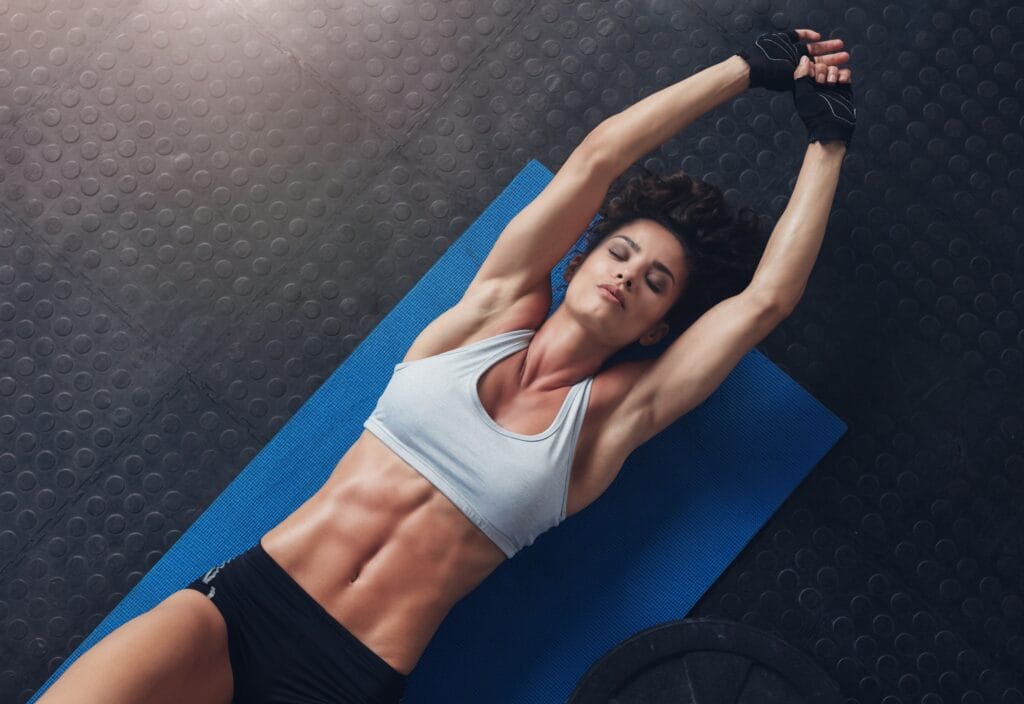
Pilates is a popular form of exercise that focuses on strengthening the core, improving flexibility, and enhancing overall body awareness.
And whether you’re new to Pilates or looking for simple yet effective exercises to incorporate into your home workout routine, this post has got ya covered.
In this article, I’ll highlight some of the easiest Pilates exercises that you can do from the comfort of your living room.
And don’t worry, you don’t need a reformer or any other expensive equipment either.
We’ll also take a look at some of the perks of doing these exercises in the first place, including all the mental and physical benefits they offer.
So grab a mat, find a quiet space, and let’s get started on your journey to a stronger, more balanced body.
7 Easy Pilates Exercises for Beginners
1. Pilates Hundred
- Starting Position: Lie on your back with knees bent, feet flat on the mat, arms by your sides.
- Movement: Inhale deeply, and as you exhale, lift your head and shoulders off the mat. Extend your legs to a 45-degree angle and begin pumping your arms up and down in a controlled motion.
- Repetitions: Perform 10 sets of 10 breaths (100 pumps in total), focusing on maintaining a stable core and controlled breathing.
2. Pilates Roll-Up
- Starting Position: Lie on your back with legs extended, arms reaching overhead.
- Movement: Inhale, and as you exhale, engage your core and slowly roll up, reaching for your toes. Inhale at the top, and exhale as you articulate your spine back down to the starting position.
- Repetitions: Perform 8-10 repetitions, focusing on maintaining a smooth and controlled movement throughout.
3. Pilates Leg Circles
- Starting Position: Lie on your back with legs extended straight up towards the ceiling.
- Movement: Keeping your core engaged, circle your legs outward, down, around, and back up to the starting position. Ensure your lower back stays pressed into the mat throughout the movement.
- Repetitions: Perform 8-10 circles in one direction, then reverse and perform 8-10 circles in the opposite direction.
4. Pilates Bridge
- Starting Position: Lie on your back with knees bent, feet hip-width apart, arms by your sides.
- Movement: Inhale, and as you exhale, press through your heels and lift your hips off the mat, creating a straight line from shoulders to knees. Inhale at the top, then exhale as you lower back down with control.
- Repetitions: Perform 10-12 repetitions, focusing on engaging your glutes and maintaining a neutral spine.
5. Pilates Side Leg Lifts
- Starting Position: Lie on your side with legs extended, bottom arm supporting your head, top hand resting on the mat in front of you.
- Movement: Inhale, and as you exhale, lift your top leg towards the ceiling, keeping it straight and engaging your outer thigh and glutes. Inhale at the top, then exhale as you lower back down with control.
- Repetitions: Perform 10-12 repetitions on each side, focusing on maintaining stability in your core and pelvis.
6. Pilates Criss Cross
- Starting Position: Lie flat on your back on a mat with your knees bent and feet flat on the floor. Place your hands behind your head, elbows wide, to support your neck.
- Movement: Draw your navel toward your spine to engage your core muscles. Ensure your lower back stays pressed into the mat throughout the exercise. Inhale to prepare, and as you exhale, lift your head, neck, and shoulders off the mat, maintaining a neutral neck position. Rotate your torso to the right, bringing your left shoulder towards your right knee. Extend your left leg straight out at a 45-degree angle from the floor, keeping it lifted.
- Criss Cross Motion: Simultaneously switch and rotate your torso to the left, bringing your right shoulder towards your left knee. Extend your right leg straight out, hovering above the floor.
- Repetitions: Complete 10-12 reps on each side, focusing on proper control throughout.
7. Pilates Single Leg Stretch
- Starting Position: Begin by lying flat on your back on a mat with your knees bent towards your chest. Keep your hands placed on your shins, just below the knees, to support your legs.
- Movement: Inhale deeply to prepare, and as you exhale, lift your head, neck, and shoulders off the mat, maintaining a neutral neck position and a stable core. Extend your right leg straight out at a 45-degree angle from the floor while simultaneously pulling your left knee in towards your chest, holding onto your left shin with both hands.
- Switch Legs: In a fluid motion, switch legs by pulling your right knee towards your chest and extending your left leg straight out, maintaining a continuous and controlled movement. As you switch legs, release your hands from your shin and place them on your ankle or calf for added resistance. Coordinate your arm movement with your leg switch to create a fluid, rhythmic motion.
- Repetitions- perform 8-12 reps on each side and finish by bringing both knees back together and slowly lowering back to the mat.
Physical Benefits of Pilates
Core Strength and Stability
Pilates targets the deep abdominal muscles, including the transverse abdominis, obliques, and pelvic floor muscles, helping to build a strong and stable core.
By strengthening these core muscles, Pilates promotes proper alignment of the spine, pelvis, and shoulders, which can lead to improved posture and reduced risk of back pain.
Flexibility and Joint Mobility
Pilates incorporates a series of dynamic stretches and movements that help to improve flexibility, range of motion, and joint mobility.
By elongating and stretching the muscles during exercises, Pilates helps to improve flexibility and reduce muscle tightness and stiffness.
And improving flexibility is a great way to help protect your back and hips from injury, as well as help manage existing pain.
Balanced Muscle Development
Pilates emphasizes balanced muscle development, targeting both the superficial and deep muscle groups to create a harmonious balance throughout the body.
It also focuses on functional movements and exercises that mimic everyday activities, aka “functional training”, which can help improve overall strength and performance in daily tasks and recreational activities.
In other words, it can make you better and safer at doing your normal routine.

Mental and Emotional Benefits of Pilates
The physical benefits of incorporating Pilates exercises into your workout routines are easy to see, but there are potential mental and emotional benefits as well.
Mind-Body Awareness
Pilates requires focused concentration on proper technique, alignment, and breathing, fostering a deeper connection between the mind and body.
And practicing mindful movement can help improve proprioceptive feedback, which can give one a better awareness of their body movement during the day.
Essentially, Pilates can help enhance body awareness, coordination, and spatial orientation, leading to improved balance and stability.
Stress Reduction and Relaxation
Pilates emphasizes controlled, rhythmic breathing patterns that help to promote relaxation and reduce stress.
The goal is to improve core strength and flexibility, but it’s also to enhance overall well-being.
Incorporating mindfulness and relaxation techniques, Pilates can help create a calming and meditative environment that helps to alleviate anxiety and promote a sense of inner peace.
Additional Benefits of Pilates
Injury Prevention and Rehabilitation
Pilates is a low-impact exercise system that places minimal stress on the joints, making it ideal for individuals recovering from injuries or seeking to prevent musculoskeletal issues.
And it can be tailored to meet specific rehabilitation needs as well (although if you aren’t being guided by a physical therapist, I can’t consider it true rehab).
Anyway, examples include helping individuals recover from injuries, surgeries, or chronic conditions by focusing on targeted exercises, movements, and modifications.
Enhanced Performance and Functional Fitness
Pilates can be adapted to complement and enhance sport-specific training regimens by focusing on core strength, flexibility, balance, and other functional movement patterns found in many sports.
I mean I can’t think of any sport where having better core strength and motor control wouldn’t help.
And as mentioned earlier, by incorporating functional movements and exercises that mimic real-life activities, Pilates may help to improve overall functional fitness during the day.
Final Thoughts
Pilates is a holistic exercise system that offers a wide range of benefits beyond just physical fitness.
And as I hope the above examples show, incorporating Pilates into your home workout isn’t complicated – all you need is a mat (or bed) and a little leg room.
Adding all or some of the Pilates exercises mentioned in this article into your home workout routine can help you build core strength, improve flexibility, and enhance overall body awareness.
I would encourage you to start with a few repetitions of each exercise, gradually increasing as you become more comfortable and confident in your technique.
Remember to maintain proper form, engage your core throughout each movement, and listen to your body.
And keep in mind – just because these exercises are low impact and straightforward doesn’t mean they’re easy.
Don’t be surprised when that soreness kicks in the next day.
But that’s a good thing because it means you got a great workout in.
With patience and consistency though, you’ll be on your way to achieving a stronger, more balanced body while enjoying the numerous benefits Pilates has to offer.


